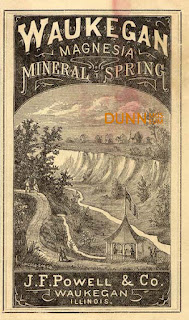After World War II, tensions developed between the two powerful nations, which came to be known as the Cold War (1947-1991). With this new enemy, Americans feared a Soviet bomber attack, similar to the Japanese attack on Pearl Harbor in 1941.
 By 1953, the U.S. Army began building Nike air defense systems around U.S. cities, industries and military installations. Nike missiles were the first operational, guided surface-to-air missiles able to detect, track and destroy enemy aircraft. Nike Ajax missiles, Fort Sheridan, circa 1965 - Dunn Museum 92.24.872
By 1953, the U.S. Army began building Nike air defense systems around U.S. cities, industries and military installations. Nike missiles were the first operational, guided surface-to-air missiles able to detect, track and destroy enemy aircraft. Nike Ajax missiles, Fort Sheridan, circa 1965 - Dunn Museum 92.24.872The Chicago area had 23 Nike missile bases with four sites in Lake County — Fort Sheridan (C-98), Libertyville (C-92 and C-94), and Barrington (C-84). These sites, and all Nike systems in the upper Midwest were supplied and maintained through Fort Sheridan.
 Though the missile sites were relatively obscure facilities with small structures on the surface, people in Lake County were aware of them, but probably not their operations. Nike Air Defense Installation making adjustments on a Nike missile, 1960 - Dunn Museum 92.24.1312
Though the missile sites were relatively obscure facilities with small structures on the surface, people in Lake County were aware of them, but probably not their operations. Nike Air Defense Installation making adjustments on a Nike missile, 1960 - Dunn Museum 92.24.1312Within a decade of their creation, Nike missiles became less crucial in the defense of the U.S. as the Soviets changed military strategy from bombers to Intercontinental Ballistic Missiles (ICBMs). Nike missiles were designed to strike enemy aircraft, not other missiles.
 John Wilkins, Electronic Fire Control Systems Repairman, shown in the guided missile shop, Building 128, Fort Sheridan, April 4, 1969 - Dunn Museum 92.24.1244
John Wilkins, Electronic Fire Control Systems Repairman, shown in the guided missile shop, Building 128, Fort Sheridan, April 4, 1969 - Dunn Museum 92.24.1244By 1974, all Nike missile sites were deactivated. Since then the abandoned bases have been used for other purposes. Some were given to school districts, or in the case of the Barrington site (on Quentin Road near Lake Zurich) temporarily housed county records and the collections of the Lake County Discovery Museum.
In 1991, the two most intact Nike installations in Illinois were documented for historic preservation purposes — site C-84 in Barrington and site SL-40 in Hecker. The Barrington site had operated only with the first generation of Nike missiles known as Nike Ajax, with a range of only about 25 miles.
 This photo was taken April 18, 1960 of Lt. Clarence Coates, C Battery, 1st Missile Bn., 517th Artillery, showing the Nike Ajax missile to visitors Oraldo Boggia (l) and John Cortesi. Boggia was an Italian exchange student at Northwestern University. He was sponsored by the Highland Park Rotary Club, of which Mr. Cortesi was a member. (Dunn Museum 92.24.1289)
This photo was taken April 18, 1960 of Lt. Clarence Coates, C Battery, 1st Missile Bn., 517th Artillery, showing the Nike Ajax missile to visitors Oraldo Boggia (l) and John Cortesi. Boggia was an Italian exchange student at Northwestern University. He was sponsored by the Highland Park Rotary Club, of which Mr. Cortesi was a member. (Dunn Museum 92.24.1289) The missile silos at Fort Sheridan were filled in (for safety) by the Lake County Forest Preserve District which was deeded the land in 1993.
For more on the history of Fort Sheridan: Fort Sheridan military lesson plans and photo cards.
For more on the successful transfer of Fort Sheridan to the Lake County Forest Preserves go to the Section 106 site: Advisory Council on Historic Preservation.







































